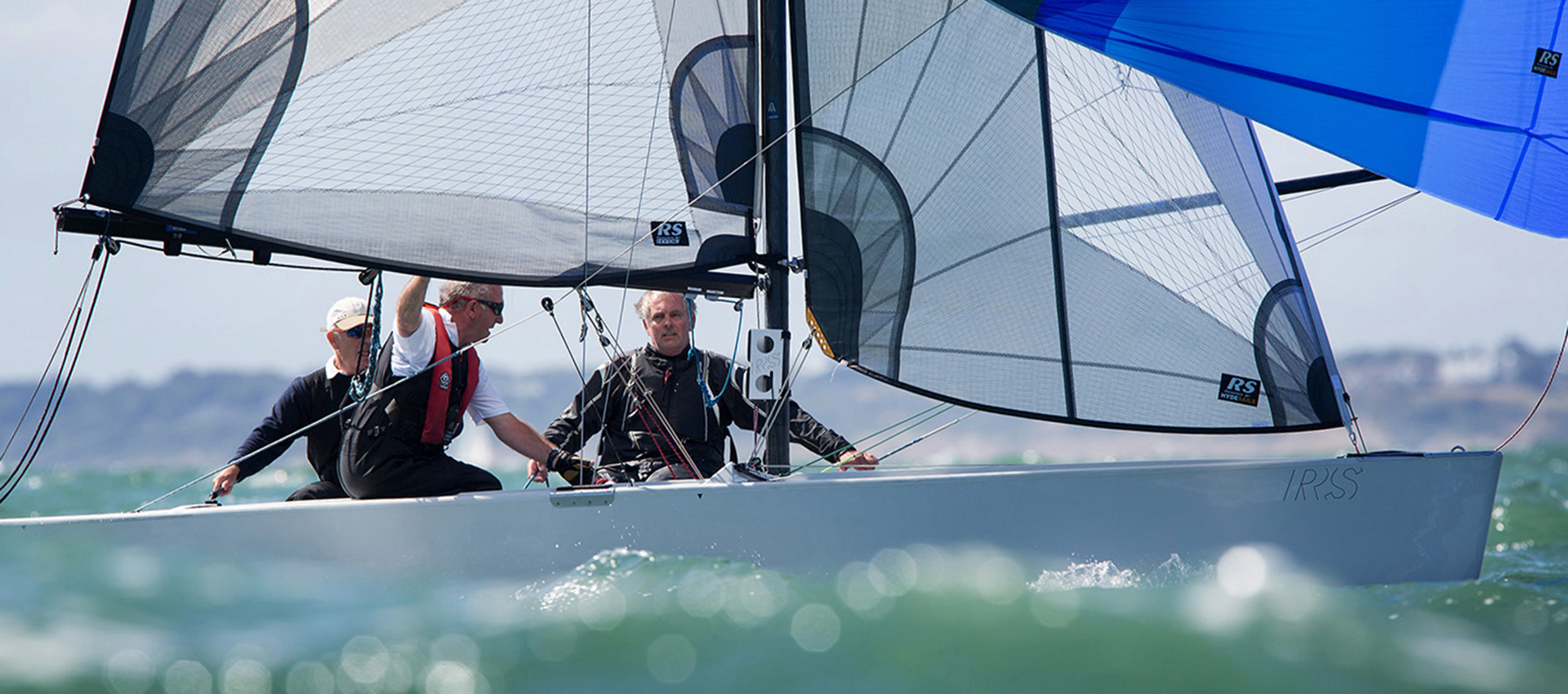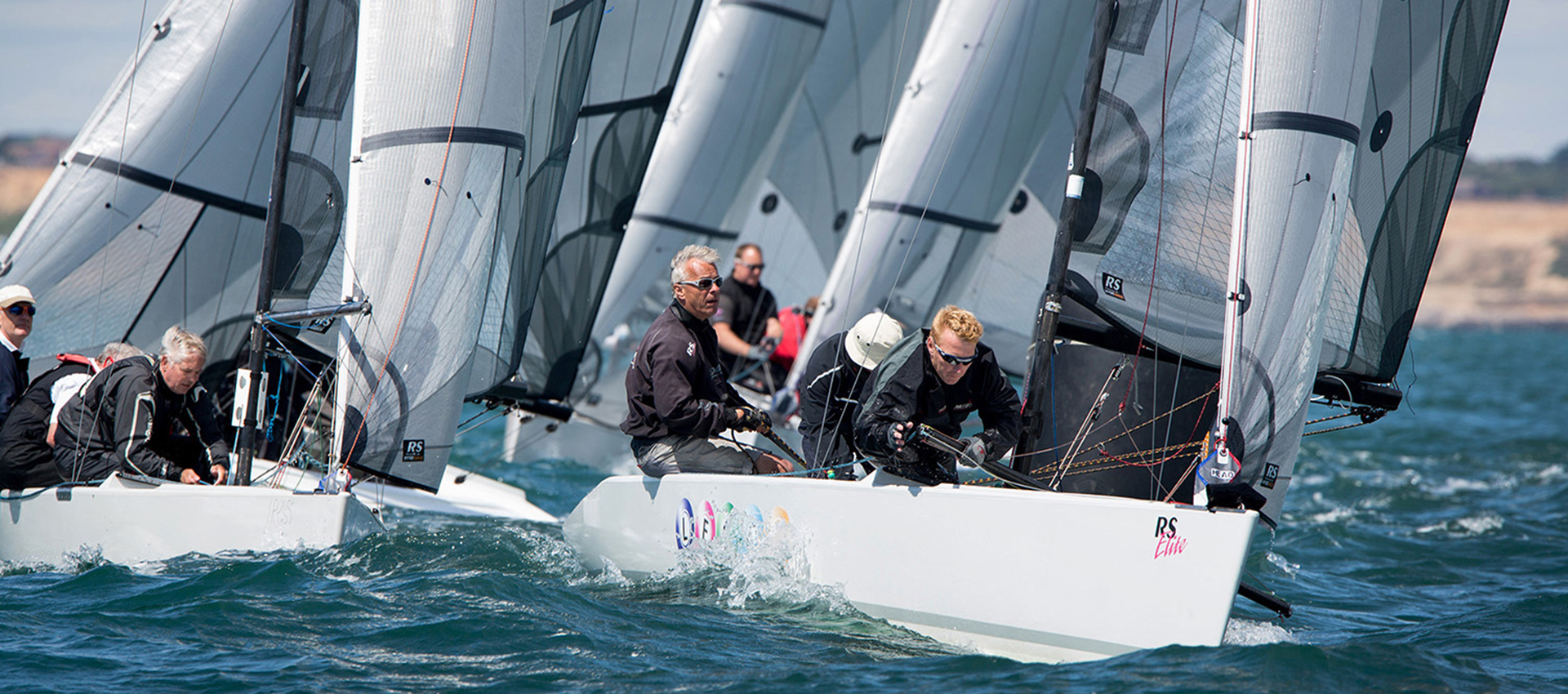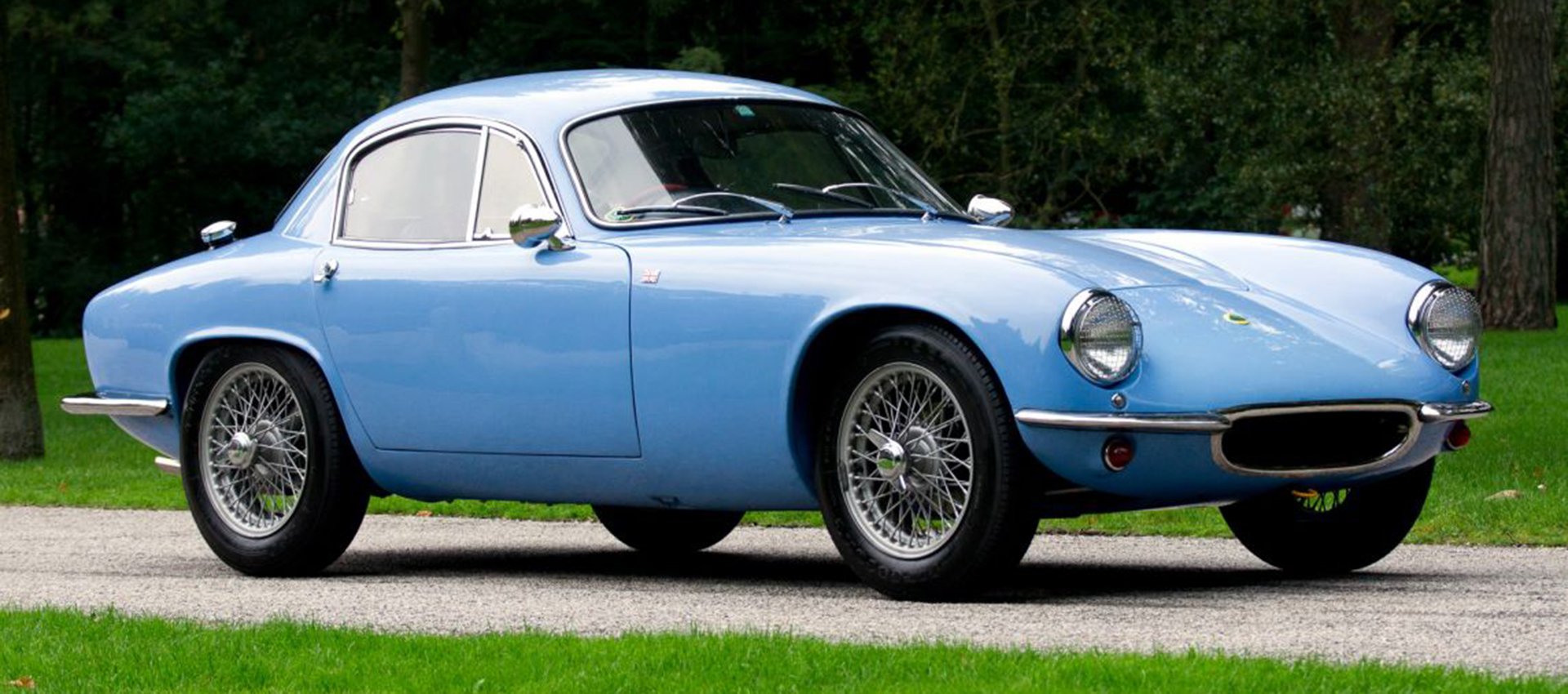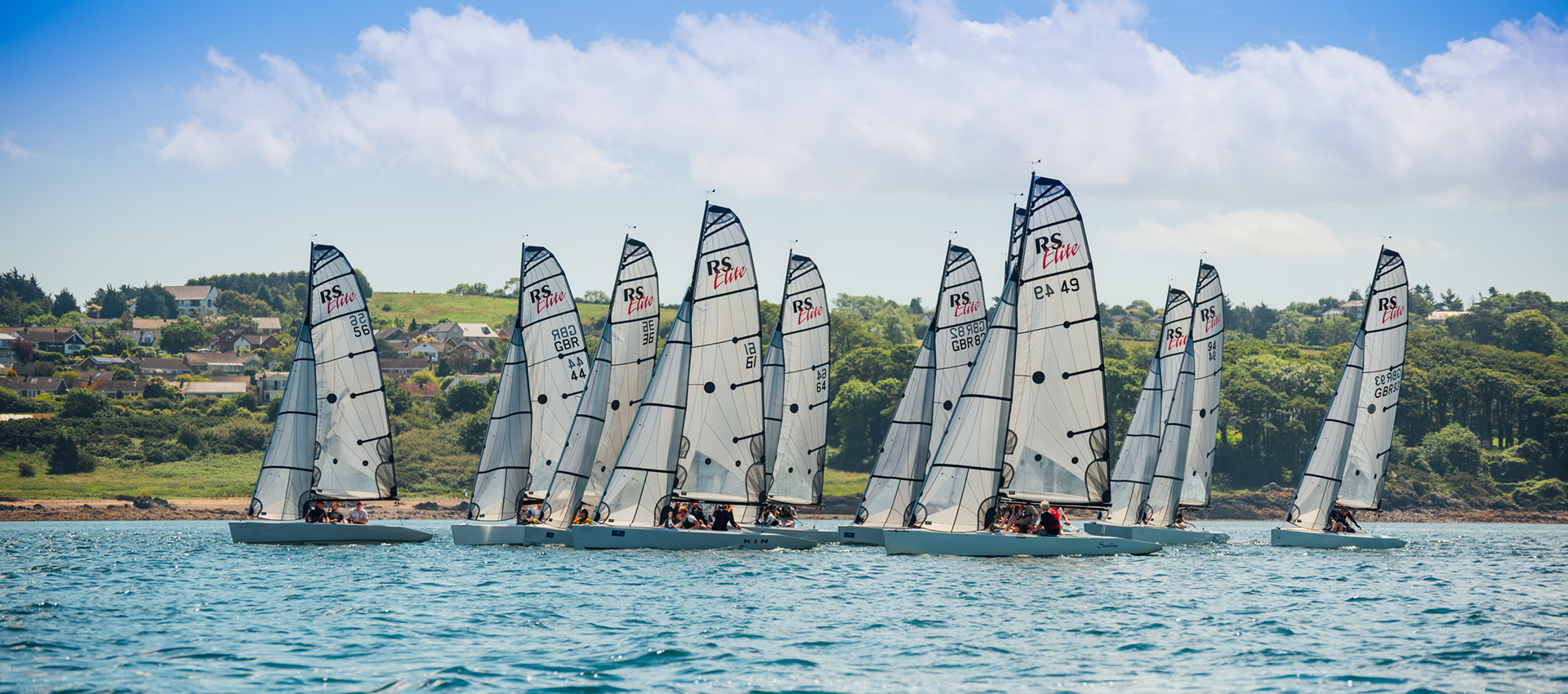
The RS Elite was commissioned and born by a group of sailors from Hayling Island Sailing Club (HISC) – on the South coast of England, just to the East of Portsmouth. Twelve boats were ordered by Hayling Island Sailing Club syndicates and a Class Association was formed to represent the interests of initial and future owners, both at HISC and elsewhere. When drawing up the specification for the boat it was labelled as a 'classic for the 21st Century' – non-hiking, and although fast, not a sportsboat. The design brief was for a boat which was suitable to sail inside Chichester Harbour, with its shoal waters and yet to be equally at home in Hayling Bay (often very choppy), and similar waters throughout the UK and beyond.
The intention is to produce a modern version of the classic racing sailboat, such as the XOD or the Swallow. The boat will be a delightful racing boat especially suited to the waters of Chichester Harbour yet still capable of taking the family for a gentle potter around the Harbour or teaching the basics of sailing. It will also be sea worthy, with enough reserve buoyancy and safety features to cross the bar and sail in the more open waters of Hayling Bay in suitable conditions.
The size, sail area and detailed features are all intended to make the boat simple and easy to handle, minimizing the requirement for physical strength, yet rewarding expert and skillful handling. The design will, as far as is possible within the constraints of size and draught, be optimised for windward work and close tacking performance.
Off wind, I have opted for a symmetric spinnaker in view of the sailing conditions in the Harbour which so often requires negotiating strong currents in light winds. I propose a modern pole handling system and have deliberately placed the pole attachment point low on the mast to minimise the physical agility and/or strength requirement in the crew.
The hull is a true keelboat, relying heavily on its bulb keel for stability, hence physical size and number of crew should make little difference to the overall performance. The aim is for a racing crew of two or three, cutting down on the cost of a round at the bar!
Hull shape will be long, graceful and elegant based on some of the modern maxi boats and America's Cup style yachts without the quirky bits. Having small overhangs, which helps in light airs and tacking, the hull shape will rapidly pick up its full sailing length when underway without having that buried look of some modern designs.
The boat will have a double bottom which will be self draining on the mooring and make the boat self recovering in the case of a knockdown or swamping. There will be room for stowing the sails and other loose gear under the side decks and in an aft locker. The intention is to produce a physically undemanding boat which is a delight to sail, looks elegant on the water and is inexpensive to own and maintain.
I have become aware of a considerable demand for such a boat not just in Chichester Harbour, and have every hope that once started the concept will gain further pockets of interest elsewhere.
Phil Morrison
April 2003

After the decision had been made to commission a new keelboat at HISC rather than select an existing one, the team who were running with the idea had to secure commitment and deposits from a number of syndicates. This was in the Summer of 2003. Racing Sailboats and Phil Morisson had revealed their plans to us in April and RS said that they would go ahead with a prototype and then into production if we could secure orders for eight boats. During the following couple of months the plans were circulated, presentations made and the 'selling' was in full flow. There was lots of interest but translating that into commitments and orders was not easy. Eventually, at about 1.30 am and towards the end of the club's Summer ball, six syndicates had agreed! I contacted RS who said they would go ahead with six and in the next few weeks details were sorted out and the project began in earnest. By the time the prototype had been half built (see later notes) there were two more syndicates and so the original target had been met. The original groupings were as follows, with some notes!
Mike Tong and Peter Wareham – Ciao Bella
Mike and I were heavily involved in the process, I had sailed with Mike a couple of times on his IRC boat Excalibur, and we thought we ought to get the ball rolling! Mike and myself sailed extensively at HISC in the first four or five years and have sailed in the Elite in nine Cowes Weeks and eight National Championships. (All of them to date!)
Anthony Penfold and Peter Chrismas – Eleanor
Anthony was also involved with the project and part owns a Contessa 32 with Peter. Gary Gledhill joined this group after a few years; they supported the class at Hayling, especially at Fed week. The boat was also chartered a couple of times and so made a few appearances at Cowes and the nationals.
'The Hayling Boat' – Fidelity
Owned by four Hayling Island Stalwarts. Nick Danby, Mick Atkin, John Pickup and Bill Bishop. Various sailing backgrounds all had and still have too many other toys! The boat was sold to Guernsey after about three seasons. Rumour has it that they had at least three dinner parties to try to select a name and that the boat was very nearly called Infidelity.
Sandy Woodward – Limelite
Sandy, of Falklands fame has sailed in and around Chichester and the Solent for many years. He was convinced that the Harbour needed a boat like the Elite and rejoined HISC as well as buying a boat to support it. He also provided a fabulous venue on the Isle of Wight for a Cowes week Bar B Q during the early years.
'The Doctor's Boat' - Eloise
Co-owned by three doctors, Richard Curties, Roger Vickers (now Sir Roger) and David Percy (Ian's father!). Competed well in the early years with various combinations of crew on board. The name Eloise came from a stable of related boat names of Richard's. The boat came third in the 2012 nationals with the son-in-law of one of the original owners helming, the daughter of another and one of my nephews crewing. He always calls me uncle Peter anyway!
Mike Dawe – Duel
Mike, a long serving HISC member with his loyal crew of Paul Carpenter and Greg Lamb often dominated the HISC and especially harbour events. Has sailed in a few Cowes weeks and some nationals including at Burnham.
Trevor and Toby - T'N T
An interesting combination. Trevor sailed with Toby's father in the past but Toby and Trevor were a new combination. Trevor sailed in the very early days at HISC but soon decided that the Elite wasn't quite the boat for him. Toby has sailed it since then with a variety of teams both at HISC and Cowes and one or two nationals.
Duncan Patterson
Another Chichester harbour sailor who liked the look of the boat and joined HISC just to sail one. He competed at Cowes and at HISC for about four years but then succumbed to work commitments and Contessa 32 cruising.
I would like to thank all of the above people and groups as being the founding fathers of the class. One of the members of one of the syndicates never actually stepped in a boat but this is not the right place to name names!
The reader might notice that the first six boats had the letters El in their names. Sandy managed to get the whole word Elite in his! An interesting idea but not a tradition that lasted long!
Peter Wareham
September 2012

The initial group of owners first saw the prototype in September 2003. A day out from Hayling Island to Devon was organised and a mini bus was borrowed. The boat was being built by Richard Woof (Woofy) at his premises near Exmouth. There was a mixed reaction when the group first saw it! Generally we were impressed, but as it didn't have a stern deck it did look a bit strange. Also, one or two people were expecting a 'sit in' rather than a 'sit on' boat, so it was a shock for them! The lines, of course were beautiful, even without a keel, just sitting on a couple of trestles. We retired to the pub for lunch and much discussion. Seeing an actual boat, albeit very incomplete, had brought alive the line drawings which was all we had seen previously.
The prototype was then completed and arrived at HISC in early December of 2003. It had a very different stern section to the production boats, an aluminium mast (the carbon one wasn't ready). The keel was further forward and the bulb was a different shape. The bailer holes were much smaller and the inside side and stern decks were straight up and down. Finally, it had dual spinnaker poles.
We sailed the boat in the harbour on the day it arrived with Nick Peters, Phil Morrison, Richard Woof, Mike Tong and myself. The following day Mike and I persuaded Nick to sail with us in the 'Xmas Box' race for cruisers. It was fairly windy and that was the now infamous story came about. We filled the boat with water, arriving at the first mark in last place, then emptied it and arrived at the next mark (downwind) in first place having registered 12 knots on the way! The water filling episode resulted in the bailers being doubled in size and the side decks being sloped, simply so that the internal space would hold less water and drain better. Also, the keel was moved to improve windward performance. Later on, the keel bulb was reshaped to its present form.
Various members of the first syndicates then sailed the boat when it was returned to HISC in early 2004. It had a reshaped stern (stern number two). Mike and I sailed it lots and fed back a few things to RS including the fact that we were not that convinced about the dual poles. We re-rigged it with a single one and RS even turned up with a carbon pole at one stage, which was great but expensive!
The stern shape was still a problem. Purely aesthetically it didn't look right, and not as good as the rest of the boat. Finally, it went off to Devon for stern number three, more or less how it is now on the production boats, and also, more or less between sterns one and two in terms of looks.
The boat was then returned to HISC after Phil, Nick and Woofy sailed it down in Devon and at Portland, making changes as required.
Next it was sailed in anger! Mike and I sailed it in the 2004 Round the Island race. Nick Peters was a bit worried as it turned out that the fin of the keel was made out of wood! Anyway, Sandy Woodward provided our pre race accommodation with his catamaran acting as our mother ship. We stayed on board at anchor with the Elite alongside in Osborne bay the night before the race. We set off at the crack of dawn for our start and had a great race. Our time still stands as an Elite record, it was about force 4–5 all day and we flew the bright yellow spinnaker lots and recorded some incredible speeds. We beat all the other dayboats and overtook many sports boats including the SB3s. Finally, the boat was used in the Cowes week 2004 by Toby Strauss and team, as their production boat hadn't quite arrived.
As the production boats were delivered in July and August 2004 the prototype disappeared from HISC but it was later upgraded to the production spec, including keel and is still sailing today.

While the original group of owners were waiting to see the prototype and for delivery of their boats there was much discussion of many things – exact specifications, colours, and of course, the name. Quite early on RS said that we could suggest names but of course, they would have a veto on it! RS had mainly given their boats numbers but with some exceptions and so a name was always a possibility.
Many ideas were put forward, some possibles and some not at all useable. For many months ideas went backwards and forwards but there were no real favourites.
Two of the original groups of owners had owned various Lotus cars over the years and in a chance discussion about various of these they both agreed about the prettiest ever Lotus, possibly the prettiest ever car of any marque was the Elite from the fifties. Anyway, that was the Eureka moment, RS were OK about it and so we are now stuck with it! Over the years it has been commented on and of course there is an unfortunate connotation about Elitism, but there we are.
At the same time, syndicates were thinking up names for individual boats and for a short time we all managed to include the letters El in the names but that didn't last beyond the Hayling boats - it's quite difficult to enforce something like that! As a result of the need to think up individual boat names one of the things that happened during the waiting for boats period was that there were many social events – we even held a golf day before anyone had sailed a boat! Dinner parties were even held to decide between 'Fidelity' and 'Infidelity' (as a boat name!)

The London Boat Show in 2005 was the planting of the seed for the first RS Elite in Ireland. Gerry Reid was over at the show working on the Zap Cat stand with Michael Browne, they were the Ireland dealers of Zap Cat. On the first day of the show while Gerry was on lunch the RS Elite caught his eye. Love at first sight! By the evening Gerry had detoured via the RS stand again this time with Michael on tow, (on their way to the Guinness stand) Michael agreed it was a nice boat, but he was more taken with the RS 400!
Every day of the show Gerry called onto the RS stand and pestered Demo (Charlie Merchant) for more information. No sales patter needed, Gerry new this was the boat for him, his own boat at the time was a particularly fast Squib Tai-Pan and the hiking had been giving him back trouble of late. The No Hiking rule on the RS Elite was an added bonus, but the boat's stunning lines, great cockpit and comfort factor all added to Gerry's enthusiasm.
On returning to Royal North of Ireland Yacht Club, Gerry enthused about the fab boat he saw at the Boat Show. However, his thoughts of a new class at Royal North were met with frostiness. First of all, the Squib class at the club was one of the largest in the UK and Gerry had a fairly fast boat, the advice was, despite back trouble, stick with the Squib, "one should never sell a fast boat". Another school of thought was if he really wanted a new boat he should buy an SB3 as this was the fastest growing class in Ireland at the time and a few members had already committed to a SB3. Trouble was that Gerry thought the SB3 looked like an ugly big dinghy, and would not necessarily help his back. With no one to race against, the RS Elite was starting to look pointless.
By September 2005 Gerry and Michael were back over in England this time at the Southampton Show, the draw to the RS stand was inevitable! By this time the RS Elite had gained an IRC certificate, the game was on again as the Elite could race in Ireland in the IRC class. Discussions took place between Martin Wadhams, Charlie Merchant and Gerry and Michael. The result was that Richard Woofe's (the Elite builder) own works boat would be sold to Ireland. The First RS Elite hull number 15 arrived in the yard at Royal North in April 2006 ready for the season.
The new Tai-Pan was parked right in the middle of the yard with the mast up, looking splendid. Very quickly, the new boat in the yard drew a lot of attention, one of the early viewers was David Baird and on the same Friday, Barney Isherwood. Both men liked what they saw. Tai-Pan sailed out of Bangor Marina for a while racing in the IRC fleet, the first big event was over in Scotland at the Scottish series in Tarbert, Loch Fyne.
On the first day of racing winds were very high gusting at 40+ knots, hairy enough on any boat never mind an Elite, competing against the big boats, Tai-Pan won the start on the first race, before long being overtaken by the much bigger boats, however with the high winds many of the big boats struggled with their gybes, broaching, with gear being lost, kites shredded and nine masts lost in one day. Tai-Pan however managed to get line honours and subsequently won the race, making the front page of the Scottish Herald. A few weeks later Tai-Pan went on to win the Mid Lough Challenge on Belfast Lough, beating a boat that hadn't lost the event for 7 years.
David Baird placed an order for the next RS Elite, followed by Barney Isherwood. By the end of the season we had three RS Elites, Tai-Pan, Jitterbug (39) and Nea Matter (43)
John Patterson followed suit and ordered his boat, Momentary Laps (44). By Christmas 2006, Brian Shaw and John Mc Dowell came out for a sail on a very cold Boxing Day. At the London Show a few weeks later an order was placed. Brian getting hull 49, Swallow, and John hull 50, Sea Breezes. Momentum was building now and Mark Hunter and Ian Hunter (no relation) ordered hull 52, Be Have, followed by Andrew Allen 53, No Match. Meanwhile, the Bangor fleet was also growing, Jitterbug and Momentary Laps had opted to sail from the marina, and they were joined by Bamboozled (17) owned by the McDonough brothers and Ian Nuttall. Around this time, Gerry Reid decided to go for the new Thai hull, and sold his boat to Fiona Hicks, renamed No Angel. Then a doctor and lawyer bought hull 36 and called it Illeagle, owned by Michael Johnston and Dr Stuart Elborn.
For the season beginning 2008, Jeff Ralston along with Gavin Brown and Simon Robinson got hull 56, Up Front, followed by Full Marks, hull 57 owned by Mark Brien (later to become our Class Chairman), Mark Ennis and Mark McNeill. The Espey family bought 58, Athelites, to add to the Bangor fleet.
Nearly everyone headed to Dublin for the Bailey Bowl and were joined by some of our English friends. For the Upfront guys this was their first event on their Elite and by the end of the weekend they were totally besotted by their new boat.
Now with a critical mass in Ireland, The Royal North were given the honour of hosting the UK RS Elite Nationals in 2009, to add to this honour Mark Brien (RNIYC) was elected as the RS Elite Associations' Chairman. Under Mark's leadership, the Irish fleet started sending large numbers to the Nationals with eight boats going to the Nationals in Lymington, nine to Royal Forth in Scotland and ten to the Royal Yacht Squadron in Cowes in 2012.
As the global recession started to bite some orders were put on hold and the momentum started to slow. Despite this, the Charity Ocean Youth Trust ordered a pair of Elites numbers 75 and 76, and they arrived early in 2010. To add to this Simon Brien of International Dragon fame, bought hull 61 and naturally called it KIN. And the following year under a tad of pressure from their friends the Vaughan's purchased hull 64 now called Toucan.